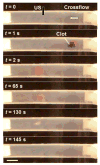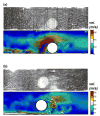Trapping of embolic particles in a vessel phantom by cavitation-enhanced acoustic streaming
- PMID: 25109407
- PMCID: PMC4216317
- DOI: 10.1088/0031-9155/59/17/4927
Trapping of embolic particles in a vessel phantom by cavitation-enhanced acoustic streaming
Abstract
Cavitation clouds generated by short, high-amplitude, focused ultrasound pulses were previously observed to attract, trap, and erode thrombus fragments in a vessel phantom. This phenomenon may offer a noninvasive method to capture and eliminate embolic fragments flowing through the bloodstream during a cardiovascular intervention. In this article, the mechanism of embolus trapping was explored by particle image velocimetry (PIV). PIV was used to examine the fluid streaming patterns generated by ultrasound in a vessel phantom with and without crossflow of blood-mimicking fluid. Cavitation enhanced streaming, which generated fluid vortices adjacent to the focus. The focal streaming velocity, uf, was as high as 120 cm/s, while mean crossflow velocities, uc, were imposed up to 14 cm/s. When a solid particle 3-4 mm diameter was introduced into crossflow, it was trapped near the focus. Increasing uf promoted particle trapping while increasing uc promoted particle escape. The maximum crossflow Reynolds number at which particles could be trapped, Rec, was approximately linear with focal streaming number, Ref, i.e. Rec = 0.25Ref + 67.44 (R(2) = 0.76) corresponding to dimensional velocities uc = 0.084uf + 3.122 for 20 < uf < 120 cm/s. The fluidic pressure map was estimated from PIV and indicated a negative pressure gradient towards the focus, trapping the embolus near this location.
Figures










References
-
- Ames WF. Numerical methods for partial differential equations. San Diego: Academic Press; 1992.
-
- Ashkin A, Dziedzic JM, Bjorkholm JE, Chu S. Observation of a single-beam gradient force optical trap for dielectric particles. Opt Lett. 1986;11:288–290. - PubMed
-
- Chen WS, Brayman AA, Matula TJ, Crum LA, Miller MW. The pulse length-dependence of inertial cavitation dose and hemolysis. Ultrasound Med Biol. 2003;29:739–748. - PubMed
-
- Coakley WT, Bardsley DW, Grundy MA, Zamani F, Clarke DJ. Cell manipulation in ultrasonic standing wave fields. J Chem Technol Biotechnol. 1989;44:43–62.
-
- Crowe C, Sommerfeld M, Tsuji Y. Multiphase flows with droplets and particles. Boca Raton: CRC Press; 1998.
Publication types
MeSH terms
Grants and funding
LinkOut - more resources
Full Text Sources
Other Literature Sources
